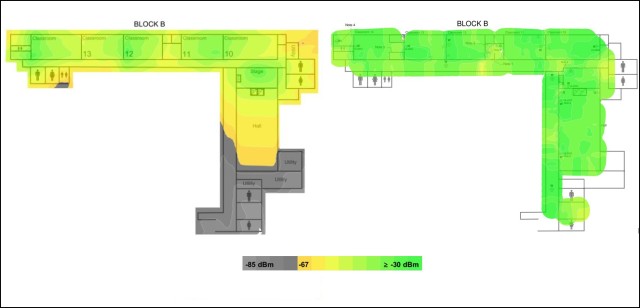Designing Wi-Fi for modern learning environments
Achieving good Wi-Fi coverage across a site requires expert understanding of how the built environment affects RF signals and which technologies are appropriate to solve issues.
Te Pā o Rākaihautū School, a composite (year 1-15) school in Linwood, Christchurch, had been struggling with poor Wi-Fi coverage and speed.
The school’s Wi-Fi setup was providing minimal coverage in some parts of the school, including the hall, admin areas and B Block while C Block relied on a wireless bridge connection that failed on rainy days.
The Challenge
Principal Terina Tahau says the problems were adversely affecting students' learning. “Wi-Fi issues meant our students couldn’t access Google Classroom or get online help resources such as Khan Academy or do some of their research. It was forcing us to return to a non-digital learning style and wasn’t conducive to students’ learning achievement.”
The inconsistent Wi-Fi also affected administration tasks, such as marking absences and accessing student contact numbers or health details.
The Solution
Torque IP was approached by the Ministry of Education to investigate the problems, make recommendations, and manage their implementation. Torque IP ICT consultant, Rey Sidon, says the school had undergone several ICT upgrades over the years, including installing Wi-Fi access points and gateways that weren’t well-placed and led to coverage and speed issues.
Torque IP did a full site survey including an audit of the Wi-Fi RF signal propagation, RSSI levels, signal-to-noise ratio levels, rogue access points, frequencies, channel widths, and the channels in use. A Wi-Fi signal strength heat map was produced showing exactly how the current setup was performing throughout the school.

A before and after heat map of RF signals demonstrates the value of the signal audit.
Designing an effective network requires more than just getting data, says Sidon. “You’ve got to know how to interpret the results and then apply that understanding to creating the optimal solution. This is the skill we bring to problems like this, with decades of experience in analysing, understanding, and resolving Wi-Fi network problems.”
“We used the heat map to design our solution, so that we’d be sure we were getting the coverage that met the Ministry’s standards and the school’s needs,” says Sidon.
The solution involved additional access points in optimal locations to maximise coverage and improve handover of clients between APs. The fibre backbone to B Block was upgraded with a new main cabinet setup. Fibre was also routed to C Block to replace the inadequate wireless bridge.
The result
The new set-up resolved the access and speed issue both within teaching spaces and admin areas. A post-work heat map shows coverage meeting the design requirements, with improved access and speed and no dead zones.
Terina Tahau says that the new setup has improved things greatly. “Our biggest issue was that the Wi-Fi problems stopped us creating a richer learning environment and put limitations on the learning opportunities for our students. We can now do things we couldn’t effectively do before.”